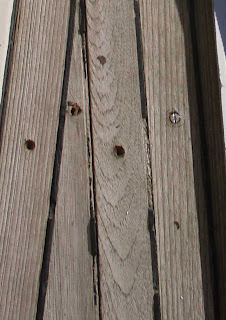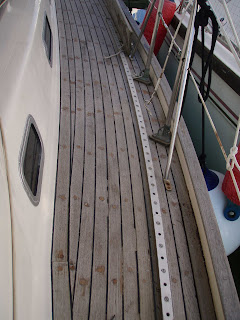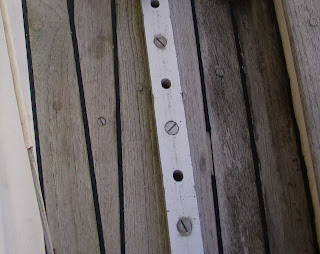 |
| Matador in live-aboard mode. The full sun awning that we acquired with the boat served as a useful circus tent and also kept the dew off the decks while we started work. |
The decks required renovation, as many of the deck screws had lost their caps, the decks were worn in places, and the black caulking was falling out. We suspected that some of the screws had moved and corroded and were allowing tiny leaks into the lockers below. It would be impossible to trace which ones were troublesome as the water tracks along ribs in the structure of the boat, so the wet lockers may not be underneath the leaky screw. We were lucky as our decks are solid and not balsa core under the teak. Had the decks been a balsa core type this operation would have been more urgent as if water gets into the balsa it must be dried out before being re sealed or rot could develop resulting in spongy decks.
 |
| Before – bare screwheads, worn teak and missing and untidy black caulking. |
Step 1
First Steph uncapped and withdrew all the screws from the decks. The screws are only there to hold the deck in place when it is first laid – it is glued or epoxied in place so the screws are superfluous. Some screws had been replaced in the past with slightly longer ones that went down too far and pierced through the fiberglass decks, creating a pathway for sea-water and rain.
One problem is that due to corrosion, about 10% of the screwheads would break off during this process and could not be withdrawn. Using a small plug-cutter on the drill it is possible to drill down around the shaft of the screw, leaving the screw standing with a hole around it. It was then possible to draw the screw using pliers. The really stubborn ones required the screw to be heated up using a small grindstone and a dremel, until the screw smoked.
This heat softened the fiberglass around the screw, breaking its hold and it could be twisted and pulled out with pliers.
Repeat 1000 times!!!
 |
The screws removed – about 10% of the heads snapped off due to corrosion – these had to be drilled out
There were approximately 1000 screws in the decks! |
Step 2
The holes were all drilled out to the same diameter to reveal the top of the fiberglass deck beneath the teak. We were relieved to see that the teak was about 8mm thick, so we know that we are OK to sand it. The most successful drill bit for this operation was a spade drill bit which Stuart had to grind down for a perfect fit for the new deck plugs. The pointed tip of the spade drill was placed in the old screw hole, thus centering the drill.
Step 3
Stuart filled the holes with a white thickened epoxy, using a syringe to inject each hole to a level approximately 2mm up the teak, effectively forming an epoxy nail.. Where holes penetrated the fiberglass deck, the epoxy runs into the holes and sets, sealing it from water ingress, Some holes required a further application.
 |
| The hole on the left shows that the epoxy has dribbled into the space below the fibreglass decks, indicating that this was one of the potentially leaky screw-holes. After leaving the first dose of epoxy to cure for 30minutes a second dose filled the holes and it looked like all the others. |
Step 4
Once the epoxy had cured, the holes were recapped with teak plugs, which were glued or clear- epoxied into position. Stuart tried both techniques and found that, although a bit messy to work with, the epoxy worked better at filling any gaps around the teak plug. Overspill didn’t matter as once set the excess can be chiseled and sanded off. Where the extraction of the screw had spoiled the edges of the hole, a slightly larger hole was drilled and a larger plug made in order to make a good fit.
The glue used was a one-part expanding polyurethane wood glue. You can find a type of this glue called Balcotan on the Robins timber website (although we used a local equivalent purchased from the local carpenter – we never found this product in chandleries, hardware shops or builders merchants despite them all being very well stocked).
We made our own teak plugs out of a block of solid teak (50cm x 11cm x 6cm), using a plug cutter on the drill. Once the glue or epoxy was thoroughly hardened the plug and excess glue was chiseled level with the surface. Sanding later will remove the last little stains and blemishes.
 |
| End of Part 1 – a spotty deck |
Next thrilling installment – the removal of the caulking, re-route the grooves and re-fill with new caulking – and Stuart's home-made tools……….and then for the final sanding………
 |
| Step 1 Cut through the old caulking with a stanley knife |
|
|
|
 |
| Step 2 Scrape out the old black stuff |
 |
| Step 3 , scraping with a home made tool |
 |
| Step 4 Filing with a homemade file |
|
 |
| Step 5 Routing the grooves |
 |
| Step 6 Cleaned and primed slots |
 |
| Step7 Filling with DC280 |
|
 |
| Step 8 Spreading |
|
 |
| Step 9 Ready for sanding |
PS I now have a Fein Multi master machine which has attachments for removing caulking and seems to be the choice of many deck repairers. They are magnificent tools on a boat,not just for decks.




















